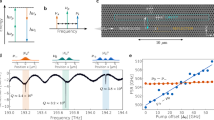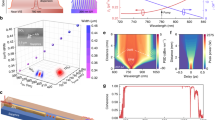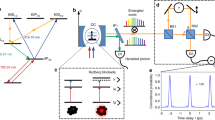Abstract
Ultrafast, ultraviolet light pulses are a key tool for spectroscopic studies (for example, molecular formation1,2 and carrier dynamics in semiconductors3) as well as a source for non-classical states of light4,5,6,7,8,9,10,11,12,13. The power required for many nonlinear processes makes amplifier systems mandatory, which significantly reduces the available repetition rate and thus often lengthens the experimental acquisition time. Here we adopt techniques recently developed for the infrared regime14,15,16 to design the first enhancement cavity for femtosecond ultraviolet pulses. An average ultraviolet power of more than 7 W at a repetition rate of 81 MHz is now available to pump a nonlinear crystal inside the cavity, applied here to implement a powerful source for high-rate experiments with entangled multiphoton states. The field enhancement enables a new scale of experiments in photonic quantum logic and in nonlinear optics research, for example, to operate optical parametric amplifiers at high repetition rates or to create high-harmonic-frequency combs14,15,16.
This is a preview of subscription content, access via your institution
Access options
Subscribe to this journal
Receive 12 print issues and online access
$209.00 per year
only $17.42 per issue
Buy this article
- Purchase on Springer Link
- Instant access to full article PDF
Prices may be subject to local taxes which are calculated during checkout



Similar content being viewed by others
References
Schrader, T. E. et al. Light-triggered β-hairpin folding and unfolding. Proc. Natl. Acad. Sci. USA 104, 15729–15734 (2007).
Schriever, C., Lochbrunner, S., Riedle, E. & Nesbitt, D. J. Ultrasensitive ultraviolet-visible 20 fs absorption spectroscopy of low vapor pressure molecules in the gas phase. Rev. Sci. Instrum. 79, 013107 (2008).
Choi, C. K., Kwon, Y. H., Krasinski, J. S., Setlur, G. & Song, J. J. Ultrafast carrier dynamics in a highly excited GaN epilayer. Phys. Rev. B 63, 115315 (2001).
Bouwmeester, D., Pan, J.-W., Daniell, M., Weinfurter, H. & Zeilinger, A. Observation of three-photon Greenberger–Horne–Zeilinger entanglement. Phys. Rev. Lett. 82, 1345–1349 (1999).
Kiesel, N., Schmid, C., Tóth, G., Solano, E. & Weinfurter, H. Experimental observation of four-photon entangled Dicke state with high fidelity. Phys. Rev. Lett. 98, 063604 (2007).
Lu, C.-Y. et al. Experimental entanglement of six photons in graph states. Nature Phys. 3, 91–95 (2007).
Wieczorek, W., Schmid, C., Kiesel, N., Pohlner, R., Gühne, O. & Weinfurter, H. Experimental observation of an entire family of four-photon entangled states. Phys. Rev. Lett. 101, 010503 (2008).
Prevedel, R. et al. Experimental realization of Dicke states of up to six qubits for multiparty quantum networking. Phys. Rev. Lett. 103, 020503 (2009).
Wieczorek, W., Krischek, R., Kiesel, N., Michelberger, P., Tóth, G. & Weinfurter, H. Experimental entanglement of a six-photon symmetric Dicke state. Phys. Rev. Lett. 103, 020504 (2009).
Walther, P. et al. Experimental one-way quantum computing. Nature 434, 169–176 (2005).
Zhao, Z., Chen, Y.-A., Zhang, A.-N., Yang, T., Briegel, H. J. & Pan, J.-W. Experimental demonstration of five-photon entanglement and open-destination teleportation. Nature 430, 54–58 (2004).
Lanyon, B. P. et al. Experimental demonstration of Shor's algorithm with quantum entanglement. Phys. Rev. Lett. 99, 250505 (2007).
Rådmark, M., Żukowski, M. & Bourennane, M. Experimental test of fidelity limits in six-photon interferometry and of rotational invariance properties of the photonic six-qubit entanglement singlet state. Phys. Rev. Lett. 103, 150501 (2009).
Jones, J. R., Moll, K. D., Thorpe, M. J. & Ye, J. Phase-coherent frequency combs in the vacuum ultraviolet via high-harmonic generation inside a femtosecond enhancement cavity. Phys. Rev. Lett. 94, 193201 (2005).
Gohle, C. et al. A frequency comb in the extreme ultraviolet. Nature 436, 234–237 (2005).
Ozawa, A. et al. High harmonic frequency combs for high resolution spectroscopy. Phys. Rev. Lett. 100, 253901 (2008).
Yanovsky, V. P. & Wise, F. W. Frequency doubling of 100-fs pulses with 50% efficiency by use of a resonant enhancement cavity. Opt. Lett. 19, 1952–1954 (1994).
Udem, T., Holzwarth, R. & Hänsch, T. W. Optical frequency metrology. Nature 416, 233–237 (2002).
Eisenberg, H. S., Khoury, G., Durkin, G. A., Simon, C. & Bouwmeester, D. Quantum entanglement of a large number of photons. Phys. Rev. Lett. 93, 193901 (2004).
U'Ren, A. B., Silberhorn, C., Banaszek, K. & Walmsley, I. A. Efficient conditional preparation of high-fidelity single photon states for fiber-optic quantum networks. Phys. Rev. Lett. 93, 093601 (2004).
Fulconis, J., Alibart, O., OBrien, J. L., Wadsworth, W. J. & Rarity, J. G. Nonclassical interference and entanglement generation using a photonic crystal fiber pair photon source. Phys. Rev. Lett. 99, 120501 (2007).
Li, X., Voss, P. L., Sharping, J. E. & Kumar, P. Optical-fiber source of polarization-entangled photons in the 1550 nm telecom band. Phys. Rev. Lett. 94, 053601 (2005).
Fan, J., Migdall, A. & Wang, L. J. Efficient generation of correlated photon pairs in a microstructure fiber. Opt. Lett. 30, 3368–3370 (2005).
Hänsch, T. W. & Couillaud, B. Laser frequency stabilization by polarization spectroscopy of a reflecting reference cavity. Opt. Commun. 35, 441–444 (1980).
Dicke, R. H. Coherence in spontaneous radiation processes. Phys. Rev. 93, 99–110 (1954).
Achilles, D., Silberhorn, C., Śliwa, C., Banaszek, K. & Walmsley, I. A. Fiber-assisted detection with photon number resolution. Opt. Lett. 28, 2387–2389 (2003).
Ou, Z. Y., Pereira, S. F., Kimble, H. J. & Peng, K. C. Realization of the Einstein–Podolsky–Rosen paradox for continuous variables. Phys. Rev. Lett. 68, 3663–3666 (1992).
Zavatta, A., Parigi, V. & Bellini, M. Toward quantum frequency combs: Boosting the generation of highly nonclassical light states by cavity-enhanced parametric down-conversion at high repetition rates. Phys. Rev. A 78, 033809 (2008).
Wieczorek, W., Kiesel, N., Schmid, C. & Weinfurter, H. Multiqubit entanglement engineering via projective measurements. Phys. Rev. A 79, 022311 (2009).
Acknowledgements
The authors acknowledge support for this work from the Deutsche Forschungsgemeinschaft Cluster of Excellence Munich-Center for Advanced Photonics (MAP), the European Union project Qubit Applications (QAP) and the Deutscher Akademischer Austausch Dienst/Ministerstwo Nauki i Szkolnictwa Wyzszego (DAAD/MNiSW). W.W. acknowledges support by the PhD program Quantum Computing, Control and Communication (QCCC) of the Elite Network of Bavaria and the Studienstiftung des deutschen Volkes.
Author information
Authors and Affiliations
Contributions
All authors contributed significantly to the work presented in this paper.
Corresponding author
Ethics declarations
Competing interests
The authors declare no competing financial interests.
Supplementary information
Rights and permissions
About this article
Cite this article
Krischek, R., Wieczorek, W., Ozawa, A. et al. Ultraviolet enhancement cavity for ultrafast nonlinear optics and high-rate multiphoton entanglement experiments. Nature Photon 4, 170–173 (2010). https://doi.org/10.1038/nphoton.2009.286
Received:
Accepted:
Published:
Issue Date:
DOI: https://doi.org/10.1038/nphoton.2009.286
This article is cited by
-
Free electrons can induce entanglement between photons
npj Quantum Information (2022)
-
Dressed photon-excitons in a Fabry–Pérot cavity filled with a nonlinear semiconductor
Applied Physics B (2022)
-
Study of ultrafast Rabi flopping in colloidal quantum dots at room temperature
Communications Physics (2021)
-
Towards practical quantum metrology with photon counting
npj Quantum Information (2016)
-
On-chip coherent conversion of photonic quantum entanglement between different degrees of freedom
Nature Communications (2016)



